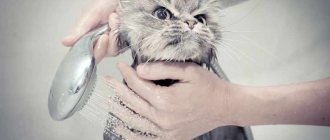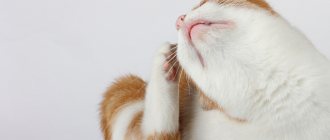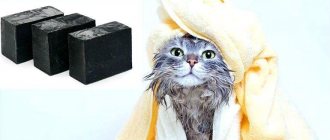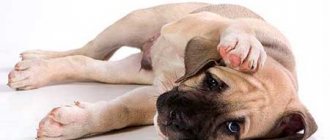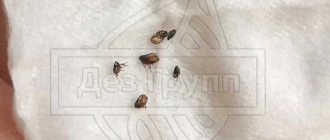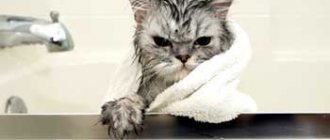Cat fleas are dangerous not only for animals, but also for people. Their bites are very itchy, and their saliva contains pathogens of dangerous diseases. If a kitten is infected with parasites, you need to rid it of this scourge as soon as possible. But in order to wash your pet with minimal stress and without harming its health, you should carefully prepare for the procedure.
From what age can it be used?
As a rule, a kitten can be bathed with flea shampoo from 8 weeks. But there are drugs with a gentle composition that can be used from the 2-3rd week. They are prepared on the basis of plant extracts, therefore they are safe for animals and repel parasites quite well.
If newborn kittens are infected with fleas, the mother cat needs to be treated with an insecticidal preparation. To do this, on the recommendation of a veterinarian, they buy drops on the withers and shampoos that can be used during lactation.
It is not recommended to wash kittens immediately after birth. They are still very weak, and it will be difficult for their body to cope with such stress.
In advanced cases, it is allowed to treat the baby with a weak solution of flea shampoo or tar soap. You need to wash your pet as quickly as possible so that he does not catch a cold.
The most painless option is to comb your baby with a fine-toothed comb. During the process, the animal is held over a bowl of water so that the fleas do not run away, but fall into it.
Important. You cannot wash your pet if it is sick. They also refuse to bathe for 14 days after vaccination, since during this period the animal’s immunity weakens.
Bathing products
Shampoos for cats are produced in powder (dry), spray and liquid (gel) form. The most popular is the last one. However, they are often not allowed to be used, otherwise the protective layer can be washed off from the skin.
Using dry shampoo to wash an adult cat
Dry shampoos are considered the best option if the animal completely refuses water treatments. All you need to do is apply the product to the coat and then comb it with a brush. In addition, it is preferable to use this type of shampoo in the cold season, when there is a chance that your pet will catch a cold after bathing.
Dry shampoo for cats
Sprays are a waterless product that is most often used for pets with long hair. This option is good in its own way. However, not all animals can withstand the notorious “zilch.” Therefore, it is better not to use this remedy for cats with weak nervous systems.
Spray for washing cats
How often can you wash your kitten with flea shampoo?
Fleas do not always die the first time, even if you wash your pet thoroughly. Insects can hide in hard-to-reach places, and some of them return after swimming.
The frequency of washing with flea shampoo depends on the brand of the product; this information is usually indicated on the packaging. Most often, it is recommended to bathe the baby again no earlier than 10 days after the first treatment. Then you need to pause for at least 2 months.
Important. If after treatment the kitten develops irritation or other allergy symptoms, you cannot wash it with the same shampoo again. You need to take your pet to the veterinarian and, together with a specialist, choose a new drug.
Even a kitten that does not go outside can get fleas. Parasites enter the house:
- together with people on clothes or shoes;
- from basements, especially if they are favored by homeless animals;
- from neighbors who have infected pets.
If your baby often itches and bites himself, you need to examine him carefully. This behavior is the first sign of the presence of parasites.
To completely get rid of insects, you need not only to wash the kitten, but also to treat the bed, carpets, upholstered furniture and secluded corners of the apartment with anti-flea agents, where eggs and larvae of parasites can remain. After all, if fleas begin to multiply en masse, it will be several times more difficult to destroy them.
Directions for use and precautions
Before treating an animal, you need to make the right choice of product.
Be sure to take into account the age of the cat. Children choose less toxic drugs with mild natural ingredients.
Insecticide-based shampoos are used when the animal is severely infested. Low-toxic agents are suitable for prevention. The instructions for many shampoos take into account the length of the cat's fur and its characteristics. Be sure to look at the expiration date.
Note! Shampoos should be used with caution for pregnant cats and small kittens.
Pet treatment
Shampoo for kittens and cats against fleas and ticks has advantages over other products.
Manufacturers are trying to make it as safe as possible. The use of shampoo allows you to quickly destroy parasites in all life cycles of their development. There are special preparations for lactating and pregnant cats and for small kittens.
Some animals suffer from allergies. Most shampoos do not contain allergenic components. They can be used for prevention. The shampoo not only eliminates parasites, but also cleanses the cat's skin and fur of dirt.
Little Briton
So, for the prevention of parasitic diseases, of all known means, shampoo is the most reliable and safe. Pet stores provide a wide selection. The product should be purchased in accordance with the individual characteristics and age of the pet.
Before using the shampoo, it is necessary to study the attached instructions, which indicate for which animals (puppies or adult dogs) it is indicated, the necessary dosages for using the medicinal product, so as not to provoke poisoning.
Before washing, your pet should be thoroughly combed using a fine-tooth comb. You need to make sure that there are no clumps of fur left, as insects can accumulate in them, and then shampooing will simply be pointless.
Applying shampoo to a dog.
When washing your dog, you need to be careful to ensure that soap suds do not get into the ears, eyes and mouth. This may cause poisoning.
After washing your pet, you need to pay attention to the area of the face, ears, and chin, where fleas could be located, and remove them. And then carefully comb the animal again with a comb to remove all dead or damaged insects. If the animal is lethargic, does not eat well, or has increased salivation, these may be signs of poisoning with a potent substance or an overdose.
In this case, you need to give your pet milk, then show it to the veterinarian
If the animal is lethargic, does not eat well, or has increased salivation, these may be signs of poisoning with a potent substance or an overdose. In this case, you need to give your pet milk, then show it to the veterinarian.
The frequency of washing depends on the specific action of the selected shampoo.
When using insecticidal agents, the period of protective action lasts from 14 to 20 days, so you should not wash your dog with a special preparation more often than the specified period, otherwise an overdose may occur.
It is necessary to strictly observe the dosage and frequency of use.
When the kitten is 1 month old (2 months), it can be washed with flea shampoo. Before this age, washing is not recommended, since the baby’s body is still fragile. During this period, the baby’s hygiene is taken care of by his mother, the cat. The kitten will go to hand when it is ready. From this period, you can use detergents until the pet is old (more than 10-15 years).
There are no special rules here. Veterinarians advise taking care of the animal’s mucous membranes, genitals, and ears. Don't rub your pet too hard. You need to use massage techniques. With its help, the animal will not have a negative reaction, it will not break out of your hands and crawl out of the water. He should feel comfortable, good and pleasant.
Home care for your animal must include bathing using detergents. The shampoo helps maintain health and get rid of a significant number of parasites even in 1 procedure. It is recommended to perform it 1-2 times every 7 days. More often it is not worth it, as the cat may develop an allergy or dislike. After this, she probably will not agree to water procedures.
In addition to water treatments against fleas, the following means are used:
- In the form of tablets.
- In the form of an aerosol.
- Impregnated collar.
- In the form of drops.
- In the form of a suspension.
- In the form of powder.
- In the form of an injection.
The most common brands are Comfortis, FrontlineCombo, Delix, Blokhnet, Harts, Doctorzu.
How to choose the right shampoo
Flea shampoos are divided into 2 types:
- preventive – contain plant extracts and essential oils that repel fleas;
- insecticides - the composition includes chemical components to kill parasites.
The shampoo should come with detailed instructions. It contains the following information:
- age from which the product can be used;
- dosage;
- terms of repeated treatments.
In addition to insecticides, the composition may include plant extracts, natural oils and other beneficial additives. They improve the structure of the coat, add shine to the coat and minimize the negative effects of chemicals on the skin.
Special “baby” flea shampoos are produced for kittens. They are not as aggressive as products for adult animals.
A kitten that does not have fleas, but is very likely to get them, can be washed periodically with preventative shampoo. Insecticides are used when parasites have already settled on the pet.
Constantly washing your cat with flea shampoo for preventive purposes is not recommended:
- Chemicals dry the skin, disrupt the functioning of the sebaceous glands, and deprive the hairs of natural protective lubricant. Because of this, the fur becomes dull and brittle.
- Poisons accumulate in the animal’s body and lead to poisoning.
The following shampoos for kittens have proven themselves to be effective in the fight against fleas:
- “Lugovoy” - contains herbal extracts for the beauty of the coat and an effective insecticide permethrin, which can destroy fleas, ixodid ticks, lice and scabies parasites. It can be used to wash kittens from 3 months.
- "Bars" - developed on the basis of plant components, is active against fleas, lice, lice and ixodid ticks. Used once for kittens from 3 months.
- “Ms. Kiss" - contains permethrin. Removes ectoparasites, cares for fur, and is used for kittens from one month old.
- "Doctor ZOO" - made with the addition of natural essential oils, has an insecticidal and repellent effect. Thanks to its natural composition, it can be used to wash kittens from 2 weeks of age.
- “Clandestine” – contains permethrin, aloe vera extract, castor and coconut oil to improve coat. Can be used from the 8th week.
- "BIO-GROOM" - made on the basis of a powerful insecticide pyrethrin. Doesn't dry out the skin and makes combing easier. Pets can be washed from 12 weeks.
- “Rolf Club” – the active ingredient is permethrin. Castor oil prevents dryness and irritation. Recommended for animals from 4 months.
- “Phytoelite” - contains permethrin, decoctions of wormwood and celandine, which relieve inflammation and itching. Suitable for kittens over 2 months old.
- "Biovax" - contains Dalmatian chamomile extract and tea tree oil, which are harmful to insects. It is allowed to wash kittens from 1 month.
- “Beaphar” is made from natural ingredients: margosa, citronella and lavender oils, which repel parasites. Suitable for allergic animals. Recommended for use from 3 months.
Pets older than six months can be washed with any insecticidal shampoo for cats in strict accordance with the instructions.
Features of the life activity of fleas on the skin of animals
Since the skin is a protective barrier, it is most susceptible to various diseases.
Cats' thick fur with an insulating undercoat traps warm air directly against the skin. A favorable temperature environment is created for the life and reproduction of fleas.
If your cat scratches its ears frequently, this may be a sign that it has fleas.
Fleas are attracted to body heat, vibrations from movement, and the smell of the cat. Dormant larvae quickly “come to life”, quickly turn into fleas, and then jump on the animal.
Ways of infection by flea parasites
- Contact with the environment and objects on which flea larvae are found.
- Contact with sick animals.
The presence of fleas in a cat is confirmed by the following symptoms
Fleas are the most common type of flightless blood-sucking parasite.
- Dullness and hair loss.
- Scratching and excessive licking of the fur (it is constantly disheveled) is a sign of flea dermatitis. A flea allergy is a reaction to a substance in flea saliva that prevents blood clotting.
- Numerous peeling flakes of skin, sometimes with a bloody stain around the edges.
- Intraepidermal hemorrhages. If you spread the fur with your hands and look at the condition of the skin, you will see distinct dark red lesions on a white background. In advanced cases, dark red scabs appear, the skin becomes covered with cracks and ulcers.
- A specific sign of fleas is the presence of insects or their metabolic products in the form of black spots (dots) on the skin. More often they are localized in the area of the hind legs (the so-called “panties”) and the back.
Intense scratching can lead to secondary infection with the development of purulent complications.
Flea bites cause pain and itching to an animal.
Additional pathogens and infections carried by fleas
- Yersinia, salmonella (affect the intestines);
- pseudotuberculosis;
- tularemia and brucellosis (especially dangerous infections);
- tick-borne encephalitis virus;
- trypanosomes.
How to properly wash a kitten with flea shampoo
For most cats, close contact with water is extremely stressful. In order not to traumatize the kitten’s psyche, you need to prepare:
- Periodically place the baby in a dry bath. To speed up addiction, place your favorite toys nearby.
- When the pet gets comfortable, carefully open the tap.
- If the baby is afraid, calm him down and stroke him gently.
- For patience and courage, reward your pet with a treat.
You cannot raise your voice or use physical force. The kitten will develop negative associations. Then in the future it will be almost impossible to wash it.
For bathing you will need a small plastic basin. Your pet will feel more comfortable in it than in a huge bathtub. Place a rubber or silicone mat on the bottom to prevent the paws from slipping. As a last resort, use a terry towel.
Warm water is poured into another container so as not to rinse the baby from a tap or shower, but to water it from a ladle or mug. A powerful jet of water can frighten your pet.
Place the shampoo at arm's length, remove the lid in advance - when there is a trembling lump nearby, there will be absolutely no time to mess with it. The dosage is calculated according to the instructions depending on the baby’s weight.
Also, towels and treats are immediately brought to the bathroom. The first ones will be needed to quickly dry your pet, the second ones – to reward for good behavior. Other items that the baby may drop or break are removed away.
Before washing the kitten, you should comb its fur and untangle the tangles. It is better to put cotton wool in your ears to prevent moisture from entering.
Important. The person who is going to wash the pet must be calm and act confidently. Otherwise, the nervousness will be passed on to the baby, and bathing will be much worse.
After all the preparations, proceed directly to washing:
- Water is poured into the basin to approximately the level of the baby’s chest. Its temperature should be +38…+40 °C.
- Place the pet in a basin and wet the fur. Let the baby grab the side - it will be calmer for him.
- To prevent the cat from running away, you gently hold it with your hand. The first few times it is better to wash the kitten with an assistant. To protect yourself from sharp claws and teeth, it is better to turn your pet with its back to you.
- The required amount of shampoo is squeezed onto your hand, lightly rubbed in your palms, then applied to the fur and distributed with massage movements. First, the neck is treated to prevent fleas from escaping to the head. It is important that the product does not get into your eyes and ears - it can cause irritation.
- The fur coat is left soaped for the time specified in the instructions. During the process, they talk to the pet in a gentle voice so that it does not get nervous.
- The shampoo is thoroughly washed off with water. The muzzle is wiped with a damp hand to prevent water from getting into the ears.
- The fur is carefully squeezed out with your hands, and the kitten is wrapped in a towel. As soon as the fabric gets wet, change it to dry. You should not vigorously rub the animal - the fur will become very tangled.
- If the room is dry and warm, the baby is released to dry on his own. Otherwise, dry the pet with a hairdryer at minimum power and at the same time comb the fur in the direction of growth.
When the fur coat is dry, the kitten is carefully examined, parting the fur. Dead fleas are combed out and thrown away. If there are live animals left, you will have to wash your pet again after the time specified in the instructions.
Important. After bathing, the baby should not go outside or be in a draft for at least 12 hours.
Animals that are terrified of water procedures can be washed with dry shampoo. It is a powder that is applied against the growth of the coat. Then the pet is combed to remove any remaining product and dead fleas.
However, such drugs are best used in emergency cases. For example, after direct contact with an infected animal, when it is not possible to wash the baby. Dry shampoos do not clean the coat as thoroughly, and if you do not brush them well, your pet runs the risk of swallowing the residue when licking.
The best dry formulations
Dry composition is very helpful at the exhibition
The main advantage of these shampoos is that they do not need to be washed off. They act instantly, refreshing the appearance of the animal, making the fur shine beautifully, look lush and well-groomed. Indispensable at exhibitions and presentations, when there is an urgent need to revive the expressive appearance of the “model”.
Excess product is combed out using a special comb. If the cat manages to lick itself, a small amount of spray will not harm its health.
“Bio Groom Klean Kitty Waterless” 237 ml – 860 RUR
Bio Groom Klean Kitty Waterless
5. “Bio Groom Klean Kitty Waterless” 237 ml – 860 RUR
The spray is sprayed directly onto the cat, there is no need to rinse it off, the composition dries completely in a matter of seconds. An ideal preparation for animals that cannot be bathed.
Advantages:
- Suitable for washing sick cats during the postoperative period
- You can clean the fur of kittens and old cats
- Includes a nutritional complex for the skin and coat
- Leaves fur soft and silky
- Deodorizes, has an antibacterial effect
- Optimal PH level for cats
Flaws:
- High consumption
- High price
TOP-8 Ways to get rid of fleas in the house: with chemicals, as well as proven folk remedies | (Photo & Video) + Reviews
Useful video
Check out visually how to wash a kitten for fleas!
When purchasing a purebred animal, be prepared for the fact that it requires more careful and expensive care. This statement especially applies to long-haired pets.
- Related Posts
- At what age can British kittens be bathed? How to wash properly for the first time?
- We bathe a small kitten at 1, 2, 3 months. Is it possible to wash a kitten?
- How to wash a kitten if there is no special shampoo? Is it possible to wash a kitten with regular shampoo?


